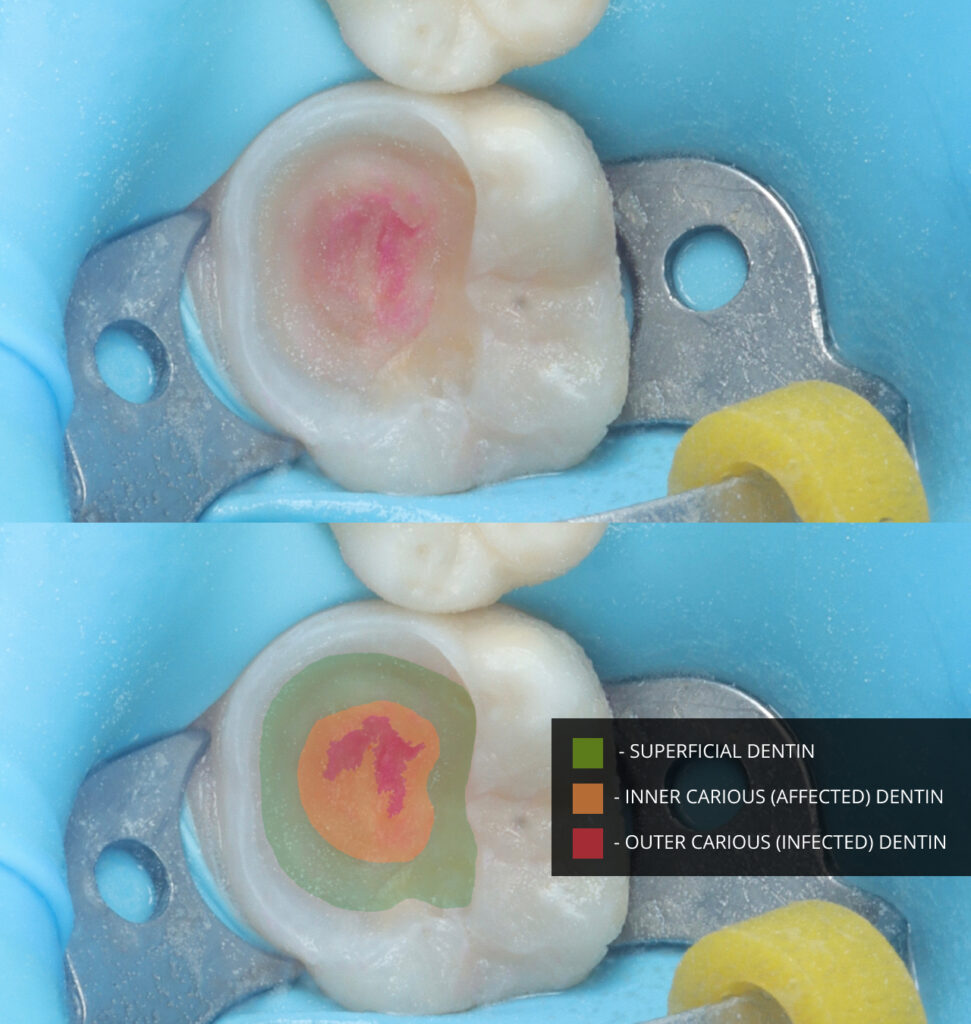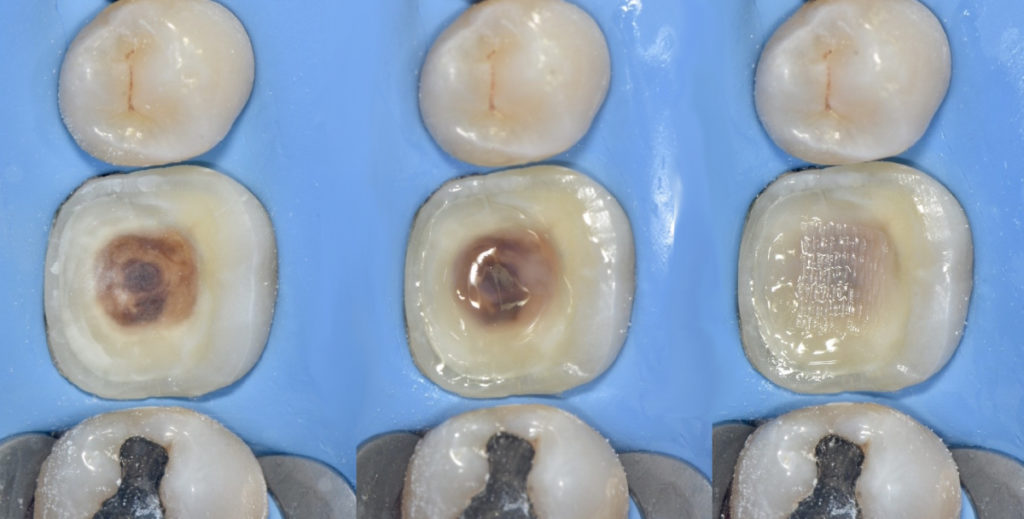Lesson 3 of the Six Lessons Approach to Biomimetic Dentistry is fundamental to understanding that the initial layers at the base of the cavity are arguably the most important layers of the restoration.
What is the Hierarchy of Bondability (HOB)?
Before learning about Immediate Dentin Sealing (IDS) and Resin Coating (RC), it is important to have an understanding of the Hierarchy of Bondability (HOB). HOB relates to the fact that different tooth substrates form different bond strengths, and these bonds take different lengths of time to develop. This can be due to the vastly different substrates (e.g. enamel and dentin); substrate conditions (e.g. inner and outer carious dentin); or the general location of the hard tissue. As these factors vary, the time taken to establish the hybrid layer varies, and the overall potential bond strength also varies. For example, outer carious dentin (infected dentin) has a lower potential bond strength compared to inner carious dentin (affected dentin), which in turn has a lower potential bond strength when compared to superficial dentin. This relates back to the concepts of the Peripheral Seal Zone (PSZ) and Caries Removal Endpoints (CRE) which are explained in Lesson 1 of the Six Lessons Approach.

Photo Credit: Dr Fran Brelsford
The approximate potential bond strengths which can be achieved are as follows:
- Superficial dentin – 50 MPa
- Inner carious (affected) dentin – 30 MPa
- Outer carious (infected) dentin – 15 MPa
- Enamel – 30 MPa
It is important to understand that in order to achieve the maximum potential bond strength in each area, the Hierarchy of Bondability must be overcome. This is explored in more detail below, in relation to Immediate Dentin Sealing (IDS), Resin Coating (RC) and Decoupling With Time (DWT).
What is Immediate Dentin Sealing (IDS)?
IDS involves carrying out bonding procedures immediately after the tooth has been prepared. This commonly involves conditioning (e.g. with total etch or self-etch systems), priming, and applying a layer of adhesive of appropriate thickness to freshly-cut dentin.
IDS allows time for the developing dentin bond to mature to its full potential strength in a stress-free environment, without influence from polymerization stress or C-Factor forces. IDS forms the first layer of the Biobase, which is discussed further in this lesson.
What are the Gold Standard Dentin Bonding Systems?
The following Dentin Bonding Systems are considered to be the gold standard adhesive systems for carrying out IDS:
- Optibond FL
- Clearfil SE Protect
- Clearfil SE Bond
The techniques for using the systems above are highly variable, and therefore an understanding of the products and subsequent interactions with varying dental hard tissues is fundamental. For example, Optibond FL makes use of a total-etch technique, whereas Clearfil SE Protect uses a self-etch technique.
As an example, when using Clearfil SE Protect, enamel and dentin are primed for 20 seconds and then air dried for 10 seconds in order to evaporate the solvent. The adhesive is then applied in a uniform layer and excess wicked away with a clean, dry micro brush. The adhesive layer is not air dried in order to prevent further air inhibition. The adhesive layer is then cured for 20 seconds. The adhesive layer of Clearfil SE Protect is much thinner than the adhesive layer of Optibond FL, therefore a layer of Resin Coating (RC) is recommended if using Clearfil SE Protect. This is explained in the Resin Coating section of this lesson.
As found in the 2000 paper by Urabe, Nakajima, Sano and Tagami, the gold standard adhesive systems can achieve bond strengths approaching that of the DEJ (approximately 50 MPa).
Which Substrate Has Higher Potential Bond Strength: Enamel or Dentin?
As shown in the 2003 paper by Van Meerbeek et al., and several other papers of a similar nature, the potential bond strength to dentin is higher than to enamel. It has to be noted, however, that this depends on several factors such as:
- Substrate being bonded to
- C-Factor stresses
- Length of time for which the bond is allowed to mature.
With the correct techniques, superficial dentin which is caries-free has a potential bond strength twice greater than that of enamel. This, again, relates to the Hierarchy of Bondability (HOB).
How Does Polymerization Stress Affect the Developing Hybrid Layer?
As previously discussed, dentin bonds take time to develop. If a bulk-fill technique is used and the developing dentin bond is connected immediately to enamel, the centre of mass of the composite will move away from the developing dentin bond (which takes more time to develop), and towards the rapidly maturing bond to enamel. This is due to the enamel being dry and the dentin being moist and flexible. By connecting these vastly differing substrates too early, the restorative material will be pulled away from the developing hybrid layer. A gap will then form at the base of the cavity, delineated by the white line seen in the Optical Coherence Tomography (OCT) studies by Hayashi et al. in 2017. Clinically, these gaps can result in the classic post-operative sensitivity commonly seen with composite restorations. By understanding the concepts in Lesson 3, this early cause of failure should be avoided.
What is Resin Coating (RC)?
Resin Coating (RC) is the technique in which 0.5 mm of microfilled, flowable composite is placed over the Immediate Dentin Sealing (IDS) layer. An example of an appropriate material to use as a Resin Coating layer is Clearfil Majesty Flow by Kuraray. Resin Coating:
- Reduces the thickness of the Oxygen-Inhibited Layer
- Allows more time for the dentin bond to develop and for the hybrid layer to mature
- Prevents transudation (movement of pulpal fluid) through the IDS layer
- Forms part of the Biobase.
The paper published by Tagami and Jayasooriya in 2003 showed that when placing a restoration on top of a layer of optimally performed IDS and RC, the bond strength to the dentin is cohesive.
What is the Oxygen-Inhibited Layer?
The Oxygen-Inhibited Layer (OIL/Air Inhibition Layer/Oxygen Inhibition Layer) is the layer in which full polymerization of the resin has not occurred due to the presence of oxygen. The oxygen can react with free radicals, rendering these unable to induce polymerization of the monomers to oligomers and polymers. This layer can commonly be between 10 and 40 microns in thickness. This can be resolved by:
- Providing more free radicals by addition of a layer of Resin Coating.
- By applying a layer of glycerine in order to block oxygen, and curing through this layer of glycerine. Note: this should only be carried out if curing the final layer of resin e.g. the final layer of the Biobase (defined later in this lesson) for an indirect or semi-(in)direct restoration, or the final, outermost layer of composite resin if carrying out a direct restoration. It is not necessary to cure the IDS/RC through a layer of glycerine if carrying out a direct restoration at the same appointment, as the subsequent layers of resin will provide the free radicals necessary at this stage.
The Oxygen-Inhibited Layer is important to consider when creating a Biobase using a bonding system with a thinner adhesive layer. For example, the adhesive layer of Clearfil SE Protect is much thinner than the adhesive layer of Optibond FL. If no RC is placed then this layer may be left vastly unpolymerized. By placing a layer of RC, the thickness is increased in order to combat the effects of the Oxygen-Inhibited Layer in this vital area. Due to the increased thickness of the Optibond FL adhesive layer, it may be appropriate to use an additional layer of Optibond FL adhesive as an RC layer.
What is Decoupling With Time (DWT)?
From the moment that IDS is carried out, the bond to dentin begins to develop and the hybrid layer starts to mature. The bond strength does not reach its maximum potential immediately – it takes time to develop.
The 2004 study by Lu et al. shows that the dentin bond reaches 90% of its potential strength after 5 minutes.
After the IDS is placed, the Resin Coating can be placed. This is commonly applied using a periodontal probe, being careful to spread evenly in 0.5 mm thickness over the dentin and DEJ. The layer of Resin Coating is moving towards the developing hybrid layer during polymerization. By allowing the dentin bond to Decouple With Time (DWT), the bond is allowed to reach its full potential without being pulled towards the faster-forming enamel bond. DWT also helps to overcome potential issues relating to the Hierarchy of Bondability, by allowing each dental substrate to form its maximum potential bond strength in a stress-free environment.
If a direct restoration is being carried out, the dentin bond should be allowed to develop in a stress-free environment for at least 5 minutes to allow the hybrid layer sufficient time to mature. During this 5 minutes, further tasks can be completed such as management of C-Factor stresses using fiber inserts; carrying out Deep Margin Elevation (DME); or building proximal walls. These concepts are discussed further in Lesson 4 of the SLA to BRD.
The Biobase and The Alleman-Deliperi Rule
The Alleman-Deliperi Rule (by Drs David Alleman and Simone Deliperi) states that the initial layers bonded to dentin should not be thicker than 1.5 mm in the first 5 minutes.
The layers placed during the first 5 minutes should therefore consist of:
- Immediate Dentin Sealing (IDS)
- Resin Coating (RC) – 0.5 mm
- 1 mm of (fiber-reinforced) composite
The above layers form part of the Biobase.

Photo Credit: Dr Haider Waleed
Taking an Impression of the Biobase
If opting for an indirect or semi-(in)direct approach, by carrying out IDS and RC at the preparation stage before taking a final impression or scan, the dentin bond is allowed time to develop and DWT can potentially take place for hours, days or weeks. This is in comparison to Delayed Dentin Sealing (DDS) where the adhesive is applied immediately before fit of the indirect or semi-(in)direct restoration. DDS does not allow time for the dentin bond to develop which may result in de-bonding of the initial layer of adhesive during polymerization at the fit appointment.
It is important to consider that if taking an impression immediately following IDS and RC, final steps must be taken to avoid unwanted reaction between the resin and impression material:
- Apply a layer of glycerin to the entire Biobase and cure through this layer to reduce the effects of oxygen inhibition.
- Finish the enamel margins by removing excess resin from the enamel.
- Clean the Biobase (e.g. with pumice) to remove any contaminants or remaining parts of the Oxygen-Inhibited Layer which may interfere with full setting of the PVS impression material. This step is not necessary if recording a digital scan of the Biobase.
Summary
By using gold standard techniques and materials to carry out Immediate Dentin Sealing (IDS) and Resin Coating (RC), and subsequently Decoupling With Time (DWT) for at least 5 minutes, the potential dentin bond strength is increased by 400% compared to Delayed Dentin Sealing (DDS).

